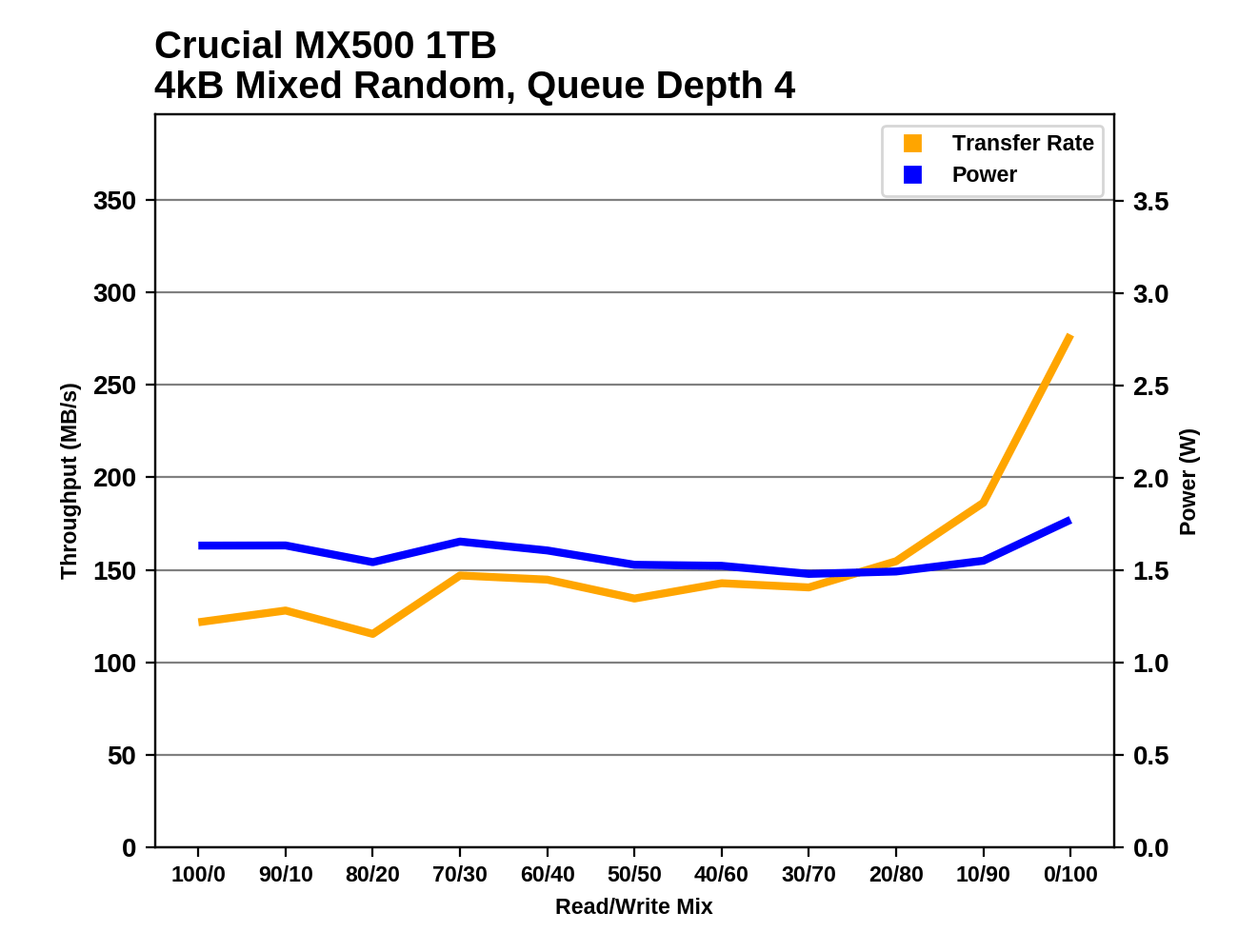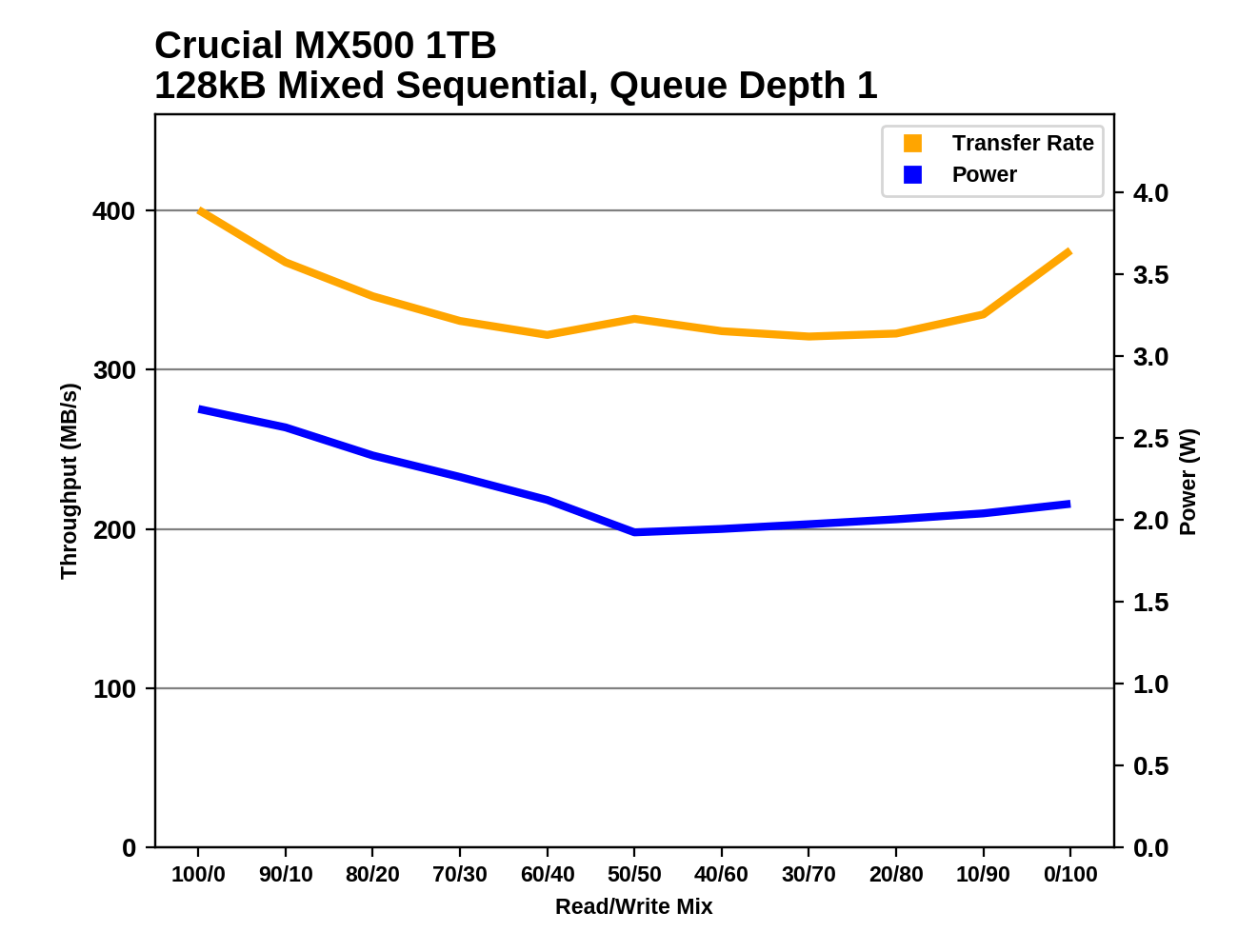The Crucial MX500 1TB SSD Review: Breaking The SATA Mold
by Billy Tallis on December 19, 2017 8:00 AM ESTMixed Random Performance
Our test of mixed random reads and writes covers mixes varying from pure reads to pure writes at 10% increments. Each mix is tested for up to 1 minute or 32GB of data transferred. The test is conducted with a queue depth of 4, and is limited to a 64GB span of the drive. In between each mix, the drive is given idle time of up to one minute so that the overall duty cycle is 50%.

The mixed random I/O performance of the Crucial MX500 is slightly slower than both the MX300 and the Intel 545s, but still above average for mainstream SATA SSDs. The 64L 3D TLC drives from Toshiba and Western Digital/SanDisk are significantly slower, and the Samsung 850 PRO and 850 EVO are still the fastest for this test.

The Crucial MX300 and Intel 545s are tied for first place for power efficiency on this test, with the MX500 coming in third place and well ahead of the other mainstream SATA drives.
 |
|||||||||
The Crucial MX500's performance during this test is a bit unsteady but generally good during the first half when the workload is more read-heavy. The MX500's speed picks up significantly when the workload becomes very write-heavy, but it take too long to start speeding up; other drives like the Samsung 850 PRO and EVO are steadily accelerating with increasing proportion of writes, starting fairly early in the test.
Mixed Sequential Performance
Our test of mixed sequential reads and writes differs from the mixed random I/O test by performing 128kB sequential accesses rather than 4kB accesses at random locations, and the sequential test is conducted at queue depth 1. The range of mixes tested is the same, and the timing and limits on data transfers are also the same as above.

The Samsung 850 PRO and EVO are the fastest SATA drives on the mixed sequential I/O test, and the Crucial MX500 falls into the second tier of drives, along with the other mainstream 64L 3D TLC drives and the MX300.

The Toshiba TR200 and OCZ VX500 score highest on power efficiency for the mixed sequential I/O test because they include little or no DRAM. The MX500 scores reasonably well overall but worse than the MX300 and the Intel 545s.
 |
|||||||||
The Crucial MX500 performs well in the early, read-heavy phases of the test but performance drops toward the middle and only recovers slightly at the end of the test. The minimum performance level across the entire test is quite high, but the fastest drives spend much less time performing at or near their minimum.










90 Comments
View All Comments
ddrіver - Thursday, December 21, 2017 - link
@Arnulf, Europe is a civilized land.sonny73n - Wednesday, December 20, 2017 - link
You remind me of the path I crossed with Samsung customer service about my 840 Evo (2 months old then).Dear valued customer,
Please contact your seller (Newegg)....
We acknowledged the issue. Please wait for firmware update....
The worst of all is that all their customer service reps don't know shit but they insisted to guide me, a veteran in IT field, how to install an SSD in my laptop. After firmware update, BSOD still happened but less frequent. Best thing I did was throwing that sucker in the trash.
Forget Shamesung and their shameless fanboys. This MX500 is a good deal but I prefer the BX300 because of MLC over TLC.
Samus - Wednesday, December 20, 2017 - link
The BX300 is such an incredibly good drive. I've outfitted 20 office PC's with them since they were introduced, no problems whatsoever.ddrіver - Wednesday, December 20, 2017 - link
@sonny73n, I'll just repost this here: https://www.usenix.org/conference/fast16/technical...Short version: the difference between SLC and MLC is almost indistinguishable. Don't imagine that MLC vs. TLC will be a world of difference either. Not with new drives.
Samus - Wednesday, December 20, 2017 - link
I had one of the worst warranty experiences ever with the 840 EVO years ago. Haven't given Samsung money since. OCZ and Mushkin, and Crucial for that matter, all have advanced RMA options and very smooth exchange processes. Crucial offers data recovery starting at $200.Samsung doesn't even return initial emails and they lie through their teeth on the phone, if you can even get ahold of the right person after being in a transfer loop for 30 minutes.
Cooe - Wednesday, December 20, 2017 - link
Recently??? Lol try well over 3 years ago. The 850 EVO's been using Samsung's V-NAND (V = vertical, as in 3D) pretty much since it's inception. In fact, they have used 3 (iirc) different types of V-NAND (differing in layer density) so far through production. You need to get with the program lol. Micron's slapping the EVO upside the head here, and I say that as someone who's bought more EVO's then I can count.lilmoe - Wednesday, December 20, 2017 - link
They just need to lower their damn price, and they'd still be good to go. Their 850 series is tried and proven, with a much better warranty, which is a significant advantage over newly released SATA models.Just cut the 850 Pro's price in half already Samsung.... I don't mind if they even cut the 10 year warranty in half dammit.
bill.rookard - Tuesday, December 19, 2017 - link
Agreed. Performance is pretty decent for a change! And having the 1TB available at the 250$ price point is also pretty aggressive as I'm sure it'll come down a stitch more in the next month or two.Samus - Wednesday, December 20, 2017 - link
The M550, MX100, MX200 and MX300 have always been decent contenders to Samsung 830, 840, 850 and 860, often priced lower and in the same performance bracket. Support and reliability are excellent.Chaitanya - Tuesday, December 19, 2017 - link
surprising crucial decided to keep mx line on tlc nand while bx was upgraded to mlc nand.